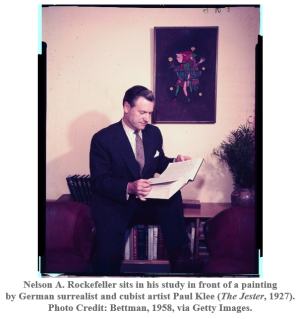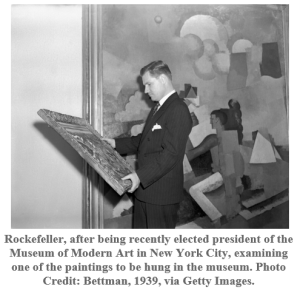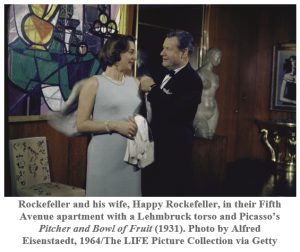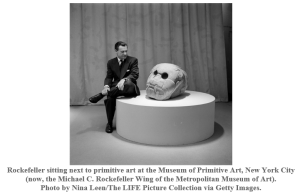
- Public Policy
- Leadership
- Funding
- News & Events
- About the Center
Back to Top Nav
Back to Top Nav
Back to Top Nav
Back to Top Nav
When Nelson A. Rockefeller became New York governor in 1959, he only had a few hours to move into the Executive Mansion in Albany before guests would arrive for his inaugural dinner party. As Alfred H. Barr, Jr.–a Rockefeller family friend and the founding director of the Museum of Modern Art (MoMA)–recalled, Rockefeller hastily, yet meticulously set up some of his favorite art pieces to be out on display, transforming the straitlaced Victorian politician residence into an energetic contemporary art gallery.[1] A cubist painting by Georges Braque hung above a sitting room fireplace, flanked by a Paul Klee. On a coffee table stood an abstract sculpture by Lynn Chadwick. As official guests entered the mansion for a formal inaugural reception, they were surrounded by walls of breakthrough contemporary art. Rockefeller's art collection, much like himself, always seemed to turn heads and intrigue onlookers.

Nelson A. Rockefeller's love for art, and especially for contemporary art, originated with his mother, Abby Aldrich Rockefeller. She displayed her eclectic collection on the seventh floor of the Rockefeller home where Nelson grew up, and during his time at Dartmouth, she granted Nelson an art collecting allowance to cultivate his independent passion for collecting.[2] As much as Abby Aldrich Rockefeller appreciated art for her own private contemplation, she also believed in making art accessible to the public. Identifying a need for an institution that challenged the classical canon of art, in 1929, she co-founded and served on the first board of the Museum of Modern Art (MoMA), where Nelson would later find himself.[3] Recalling her philosophy that art "makes one more sane and sympathetic, more observant and understanding," Nelson credited his mother for nourishing his creativity and spirit through art.[4]
nar_2.png

Rockefeller, after being recently elected president of the Museum of Modern Art in New York City, examining one of the paintings to be hung in the museum. Photo Credit: Bettman, 1939, via Getty Images.
Inspired by his mother's comparable passion for art and propelled by his own curiosity and creativity, Rockefeller's art collection included works from many different times and places. Particularly during his years in political office, Rockefeller had a personal affinity towards works of abstract expressionism, a post-World War II art movement that developed out of New York City. The busy, provocative works of Pablo Picasso and Jackson Pollock reflected Rockefeller's equally exuberant personality. Simultaneously, he also collected folk art of North and Central America, the sculpture of Africa and Southeast Asia, Japanese prints, and porcelain out of eighteenth- century Europe. Towards the later end of his life, after the American pop art movement reached its peak in the mid-1960's, Rockefeller commissioned Andy Warhol to create portraits of his wife, Happy Rockefeller, and of himself.[5]

As much as art collecting was a personal passion of his, Nelson A. Rockefeller also believed in bringing art to the public. He began shaping the art world when he was only twenty-one as a member of the MoMA's first Junior Advisory Committee, a museum of which he would later become President and a key donor.[6] After his son, Michael C. Rockefeller, vanished tragically on an expedition to New Guinea, Nelson founded New York's Museum of Primitive Art, now recognized as the Michael C. Rockefeller Wing of the Metropolitan Museum of Art.[7] As governor of New York, he established the New York State Council for the Arts: the first state government agency to provide arts subsidies and the model for the National Endowment for the Arts.[8]

As with the artists he loved, Rockefeller was a visionary; only he painted with his policies and leadership. Known for his autonomy, conviction, and unyielding efforts at solving problems with policy, Rockefeller was confident in and driven by achieving his goals. Writer Francine du Plessix Gray called him "the highest man in public office to be a champion of the avant-garde."[9]
Listed below are forty-one artworks that originally comprised a small fraction of Nelson A. Rockefeller's expansive art collection. While most of Rockefeller's collection lives in private collections or as a part of the Rockefeller family's Kykuit Estate Heritage Trust, the pieces listed are all works that now belong to art museums open to the public, including some in our very own Hood Museum! Click on each title to view the museum page and a photo of the work.
See Mary Bauermeister, High Towered, 1961-68, The National Trust for Historic Preservation, Kykuit estate, Pocantico Hills, New York.
See Umberto Boccioni, States of Mind I: The Farewells, 1911, Museum of Modern Art, New York City.
See Boccioni, States of Mind II: Those Who Go, 1911, Museum of Modern Art, New York City.
See Boccioni, States of Mind III: Those Who Stay, 1911, Museum of Modern Art, New York City.
See Lee Bontecou, Untitled, 1960, The National Trust for Historic Preservation, Kykuit estate, Pocantico Hills, New York.
See Georges Braque, The Parc at Carrières-Saint-Denis, 1909, Museo Nacional Thyssen-Bornemisza, Madrid, Spain.
See Braque, Still Life with Tenora, 1913, Museum of Modern Art, New York City.
See Braque, Still Life: "2ᵉ étude," 1914, The Metropolitan Museum of Art, New York City.
See Alexander Calder, Spiny, 1942, Museum of Modern Art, New York City.
See Giorgio de Chirico, The Song of Love, 1914, Museum of Modern Art, New York City.
See Antonio Frasconi, Calandria; Argentine Mocking-Bird, 1948, Dartmouth Hood Museum, Hanover, New Hampshire, Gift of Victor Borella, Class of 1930 and friend of Nelson A. Rockefeller, who gifted the piece to him.
See Albert Gleizes, Football Players, 1912-13, National Gallery of Art, Washington, D.C.
See Julio González, Reclining Figure, 1934, Museum of Modern Art, New York City.
See Juan Gris, Guitar, Bottle, and Glass, 1914, Museum of Modern Art, New York City.
See Gris, The Sideboard, 1917, Museum of Modern Art, New York City.
See Rockefeller's commissioned fireplace murals: Fernand Léger's Untitled (1939) and Henri Matisse's Le chant (1938), Museum of Fine Arts Houston, Texas.
See Paul Klee, Yellow Harbor, 1921, The Metropolitan Museum of Art, New York City.
See Klee, Mask of Fear, 1932, Museum of Modern Art, New York City.
See Klee, Heroic Strokes of the Bow (Heroische Bogenstriche), 1938, Museum of Modern Art, New York City.
See Franz Kline, Corinthian II, 1961, Museum of Fine Arts Houston, Texas.
See Willem de Kooning, Gansevoort Street, 1949, Stanford University (Collection of Mr. and Mrs. Harry W. Anderson), Stanford, California
See Léger, Woman with a Book, 1923, Museum of Modern Art, New York City.
See William Lehmbruck, Dancer, 1913, Museum of Modern Art, New York City.
See Matisse, Dance (I), 1909, Museum of Modern Art, New York City.
See Matisse, Odalisque in Striped Pantaloons, 1925, Museum of Modern Art, New York City.
See Matisse, Italian Woman, 1915, Guggenheim Museum, New York City.
See Joan Miró, Painting, 1933, The Broad, Los Angeles, California.
See Miró, "Hirondelle Amour," 1933-34, Museum of Modern Art, New York City.
See Louise Nevelson, White Column (from "Dawn's Wedding Feast"), 1959, National Museum of Women in the Arts, Washington, D.C.
See Pablo Picasso, Girl with the Mandolin (Fanny Tellier), 1910, Museum of Modern Art, New York City.
See Picasso, Glasses and Fruits, 1908, Museo Nacional Thyssen-Bornemisza Collection, Madrid, Spain.
See Picasso, Guitar, 1913, Museum of Modern Art, New York City.
See Picasso, Guitar on a Table, 1912, Dartmouth College Hood Museum, Hanover, New Hampshire.
See Picasso, Student with a Pipe, 1913, Museum of Modern Art, New York City.
See Picasso, Still Life: "Job," 1916, Museum of Modern Art, New York City.
See Picasso, Pitcher and Bowl of Fruit, 1923, Guggenheim Museum, New York City.
See Picasso, Interior with a Girl Drawing, 1935, Museum of Modern Art, New York City.
See Picasso, Harvesters, 1907, Museo Nacional Thyssen-Bornemisza, Madrid, Spain.
See Henri Rousseau, The Dream, 1910, Museum of Modern Art, New York City..
See Katherine Schmidt, Jack of All Trades, 1938, Dartmouth Hood Museum, Hanover, New Hampshire, Gift of Victor Borella, Class of 1930 and friend of Nelson A. Rockefeller, who gifted the piece to him
See George Segall, Shower Curtain, 1966, The National Trust for Historic Preservation, Kykuit estate, Pocantico Hills, New York.
1. Barr, Alfred H. "On Nelson Rockefeller and Modern Art." The Nelson A. Rockefeller Collection: Masterpieces of Modern Art, by William S. Lieberman and Lee Boltin, First ed., Hudson Hills, 1981, pp. 25.
2. Rockefeller, Nelson A. "Introduction." The Nelson A. Rockefeller Collection: Masterpieces of Modern Art, by William S. Lieberman and Lee Boltin, First ed., Hudson Hills, 1981, pp. 13..
3. Rockefeller, Nelson A. "Introduction." The Nelson A. Rockefeller Collection: Masterpieces of Modern Art, by William S. Lieberman and Lee Boltin, First ed., Hudson Hills, 1981, pp. 13.
4. Rockefeller, Nelson A. "Acknowledgments." The Nelson A. Rockefeller Collection: Masterpieces of Modern Art, by William S. Lieberman and Lee Boltin, First ed., Hudson Hills, 1981, pp. 5.
5. Perl, Jed. "From MoMA to Washington: How Nelson Rockefeller Redefined the Role of the Art Patron & Politician for the 20th Century." Sotheby's, Sotheby's, 24 Sept. 2018, www.sothebys.com/en/articles/from-moma-to-washington-how-nelson-rockefeller-redefined-the-role-of-the-art-patron-politician-for-the-20th-century.
6. Perl, 2018.
7. Perl, 2018.
8. Perl, 2018.
9. Perl, 2018.
Barr, Alfred H. "On Nelson Rockefeller and Modern Art." The Nelson A. Rockefeller Collection: Masterpieces of Modern Art, by William S. Lieberman and Lee Boltin, First ed., Hudson Hills, 1981, pp. 20–27.
Perl, Jed. "From MoMA to Washington: How Nelson Rockefeller Redefined the Role of the Art Patron & Politician for the 20th Century." Sotheby's, Sotheby's, 24 Sept. 2018, www.sothebys.com/en/articles/from-moma-to-washington-how-nelson-rockefeller-redefined-the-role-of-the-art-patron-politician-for-the-20th-century.
Rockefeller, Nelson A. "Acknowledgments." The Nelson A. Rockefeller Collection: Masterpieces of Modern Art, by William S. Lieberman and Lee Boltin, First ed., Hudson Hills, 1981, pp. 5.
Rockefeller, Nelson A. "Introduction." The Nelson A. Rockefeller Collection: Masterpieces of Modern Art, by William S. Lieberman and Lee Boltin, First ed., Hudson Hills, 1981, pp. 13.
Written by Cristina (Tina) Javens '23, Rockefeller Center Student Research Assistant